A Well Thought Out Scream:James Riordan Scientists Discover A New Weapon Against Disease
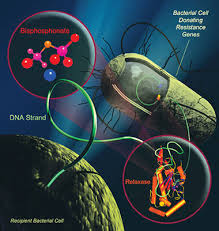
Scientists have discovered a powerful new antibiotic they say can kill an array of germs without the bugs easily becoming resistant to it, a potential weapon against a range of diseases. The discovery is a rare—and much-needed—breakthrough in the quest for new antibiotics to overcome the problem of growing resistance to existing drugs.
While the new compound was shown to be safe and effective in mice, scientists need to determine whether this is the case for people.
The discovery of the new class of antibiotic, called teixobactin, was uncovered by screening 10,000 bacterial strains from soil. Teixobactin will be investigated further in animals before being tested in people. If all goes well, “we’ll be in clinical trials two years from now,” said Kim Lewis, a professor at Northeastern University in Boston and lead author of the study. Human trials could take two to three years, he added.
Kim Lewis, University Distinguished Professor and Director of the Antimicrobial Discovery Center in the College of Science. BROOKS CANADAY/NORTHEASTERN UNIVERSITY
Antibiotics, discovered in the early 20th century, transformed medicine. Most are chemical substances extracted from certain bacteria that can kill or damage other bacteria that cause human and animal diseases. Because of widespread and indiscriminate use of antibiotics, bacteria in recent years have acquired mutations and new genes that render them more resistant to drugs. At the same time, antibiotic research at pharmaceutical companies stalled.
This dual problem—the rise of resistant bacterial strains and the lack of new antibiotics—threatens to undermine many advances of modern medicine. Infections are becoming harder to control; standard treatments are less effective; illness and hospital stays are getting longer; and there are more deaths from infection.
“It’s one of the most significant threats to global health we’re looking at,” said Charles Penn, who coordinates the World Health Organization’s response to antimicrobial resistance.
In the U.S. alone, at least 2 million illnesses and 23,000 deaths can be attributed each year to antibiotic-resistant bacteria, according the U.S. Centers for Disease Control and Prevention.
About 80% of all antibiotics are derived from microbes or fungi in the environment, while the rest are synthetic. But of the naturally occurring microbes, only 1% can be properly grown and cultured in a laboratory dish. As a result, scientists have been unable to tap the vast storehouse of “uncultured” bacteria as a source of new antibiotics.
The key advance by Dr. Lewis and his colleagues is their invention of a way to search for antibiotics in this hitherto unexplored pool—the 99% of microbes that only thrive in their natural environment.
In the approach reported in Nature, the scientists used a tiny plate-like device, called an iChip, which is dotted with several hundred chambers. A cell from a different bacterium is dropped into each of the chambers and the iChip is placed under the soil. There, the individual bacteria go on to grow naturally and form colonies.
The bacteria are placed on a petri dish and overlaid with a target bacteria called Staph. After a while, if there is an empty zone in the petri dish it means the colony below is making an antibiotic that prevents the growth of the Staph in the layer above.
After screening 10,000 strains this way, the researchers found one substance that appeared to be especially potent. In various tests, including some on mice, teixobactin was shown to be effective against bacteria that cause certain types of pneumonia, tuberculosis and the staph infection called Staphylococcus aureus, or MRSA, which infects 1 million Americans annually. The animals didn’t suffer any serious side effects.
However, teixobactin didn’t turn out to be effective against most strains of certain organisms known as ‘Gram-negative bacteria,’ which can be especially hard to treat with many existing antibiotics. These include the bugs that cause cholera, gonorrhea and several common food-borne illnesses.
Teixobactin kills bacteria by binding on to multiple targets and by causing the cell walls to break down. According to the authors, this mechanism suggests that it could be many decades before any resistant strains emerge—a property that makes the compound especially promising.
Dr. Lewis and co-author Slava Epstein of Northeastern University developed the iChip and related technology, and co-founded closely held NovoBiotic Pharmaceuticals of Cambridge, Mass., to commercialize their research.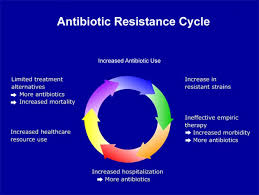
Novobiotic has so far discovered 25 new antibiotics using the approach. The company owns the patent for teixobactin.
“They’ve looked where no one was looking before,” said Gerard Wright, a professor of biochemistry at McMaster University in Canada, who wasn’t involved in the Nature study. “In a field full of doom and gloom, they’ve shown us a new way to develop antibiotics.”




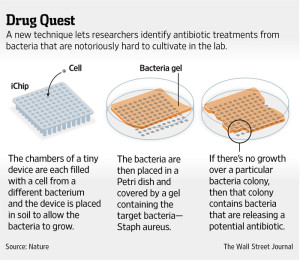

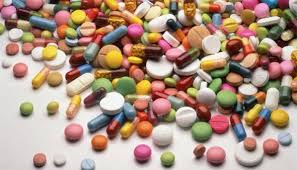
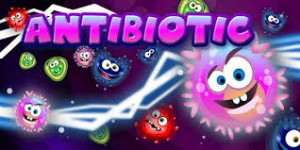

No Comment